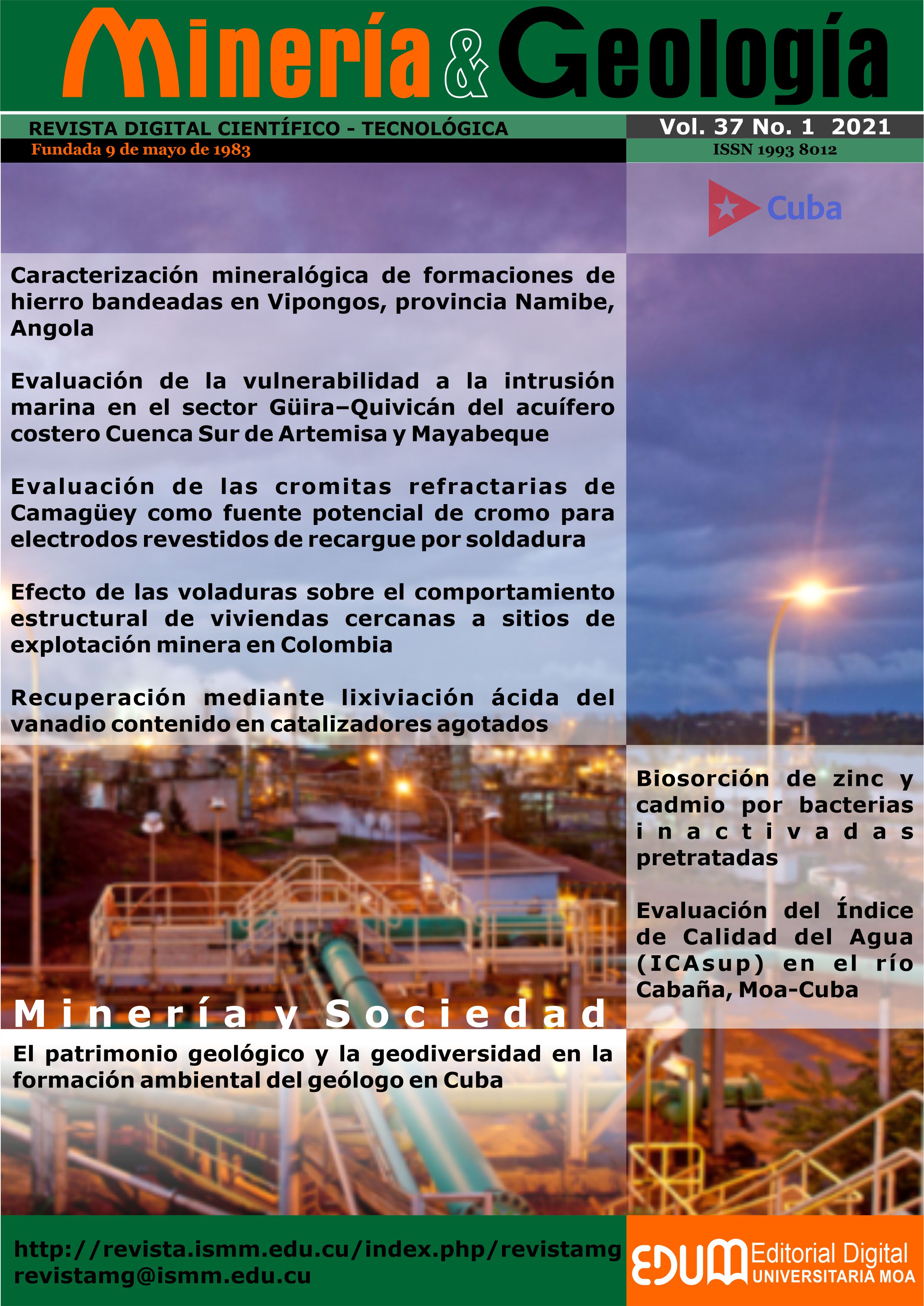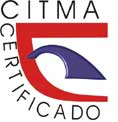Biosorption of zinc and cadmium by pre-treated inactive bacteria
Keywords:
heavy metals, biosorption, inactivated bacteria, bimetallic solution, zinc, cadmium, biomass.Abstract
An alternative for reducing heavy metals in different ecosystems is the use of microorganisms in bioremediation processes, one of the main environmental problems of the present century. The aim of this work is to determine the effectiveness of bacterial, pretreated, and inactivated biomasses in biosorption of zinc (Zn (II)) and cadmium (Cd (II)) in monometallic and bimetallic solutions. Dry heat was applied to inactivate biomasses of Bacillus cereus (AL-30), Acinetobacter sp. (AL-134) and Micrococcus sp. (AL-138); subsequently they were treated with KOH and HCl. In all cases, a significant increase in obtaining values of both ions, higher than 40 mg.g-1, was found. These results allowed forming different mixed bacterial systems which were efficient in biosorption, from monometallic solution, with percentages over 91,4 % and 87,6 %, for Zn (II) and Cd (II), respectively. In the bimetallic solution, a higher capture of cadmium regarding zinc was observed by mixed bacterial systems. The potentialities of the inactivated bacterial biomass and with chemical pretreatment to be used in effluent purification processes with the presence of these metals were evidenced.Downloads
References
Álvarez, A.; Sáez, J. M.; Costa, J. S.; Colin, V. L.; Fuentes, M. S.; Cuozzo, S. A.; Benimeli, C. S.; Polti, M. A. y Amoroso, M. J. 2017: Actinobacteria: Current research and perspectives for bioremediation of pesticides and heavy metals. Chemosphere, 166: 41-62.
Barange, M.; Srivasta, A.; Srivasta, J. y Palsania, J. 2014: Biosorption of heavy metals from wastewater by using microalgae. International Journal of Chemical and Physical Sciences, 3(6): 67-81.
Barros, M. J.; Macedo, G. R.; Duarte, M. M. L.; Silva, E. P. y Lobato, A. K. 2003: Biosorption of cadmium using the fungus Aspergillus niger. Brazilian Journal Chemical Engineering, 20(3): 1-17.
Bhutada, S. A. y Dahikar, S. B. 2017: Evaluation of removal of heavy metals by microorganisms isolated from industrial effluents. Journal of Applied and Advanced Research, 2(3): 156-160.
Choińska-Pulit, A.; Sobolczyk-Bednareka, J. y Łaba, W. 2018: Optimization of copper, lead and cadmium biosorption onto newly isolated bacterium using a Box-Behnken design. Ecotoxicology and Environmental Safety, 149: 275–283.
El-Naggar, E. N.; Hamouda, R. A.; Mousa, I. E.; Abdel-Hamid, M. S. y Rabei, N. H. 2018: Biosorption optimization, characterization, immobilization and application of Gelidiuma mansii biomass for complete Pb2+ removal from aqueous solutions. Scientific Reports, 8(1): 1-19.
Holan, Z. y Volesky, B. 1994: Biosorption of lead and nickel by biomass of marine algae. Biotechnology and Bioengineering, 43: 1001-1009.
Hu, W.; Dong, F.; Yang, G. y Peng, X. 2017: Synergistic interface behavior of strontium adsorption using mixed microorganisms. Environmental Science Pollution Research, 25(23): 22368-22377.
Jaafari, J. y Yaghmaeian, K. 2019: Optimization of heavy metal biosorption onto freshwater algae (Chlorella coloniales) using response surface methodology (RSM). Chemosphere, 217: 447-455.
Jiang, L.; Zhou, W.; Liu, D. y Liu, T. 2017: Biosorption isotherm study of Cd2+, Pb2+ and Zn2+biosorption onto marine bacterium Pseudoalteromonas sp. SCSE709-6 in multiple systems. Journal of Molecular Liquids, 247: 230-237.
Khan, T. A.; Mukhlif, A. A.; Khan, E. A. y Sharma, D. K. 2016: Isotherm and kinetics modeling of Pb (II) and Cd (II) adsorptive uptake from aqueous solution by chemically modified green algal biomass. Modeling Earth Systems Environment, 2: 117-131.
Mahmoud, M. E.; El Zokm, G. M.; Farag, A. E. M. y Abdelwahab, M. S. 2017: Assessment of heat-inactivated marine Aspergillus flavusas a novel biosorbent for removal of Cd (II), Hg (II), and Pb (II) from water. Environmental Sciences Pollution Research, 24(22): 18218-18228.
Mane, P. C.; Bhosle, A. B.; Vishwakarma, C. V. y Tupkar, L. G. 2010: Effect of pretreatment of algal biomass on bioadsorption of manganese. International Journal of Engineering Science and Technology, 2(12): 7550-7554.
Migahed, F.; Abdelrazak, A. y Fawzy, G. 2016: Batch and continuous removal of heavy metals from industrial effluents using microbial consortia. International Journal of Environmental Science and Technology, 14(6): 1169-1180.
Nagase, H.; Intorn, D.; Oda, A.; Nishimura, J.; Kajiwara, Y.; Parek, M. O.; Hirata, K. y Miyamoto, K. 2005: Improvement of selective removal of heavy metals in cyanobacteria by NaOH treatment. Journal of Bioscience and Bioengineering, 99(4): 372-377.
Okoli, C. P.; Diagboya, P. N.; Anigbogu, I. O.; Olu-Owolabi, B. I. y Adebowale, K. O. 2017: Competitive biosorption of Pb (II) and Cd (II) ions from aqueous solutions using chemically modified moss biomass (Barbulalam barenensis). Environmental Earth Sciences, 76(33): 1-10.
Pethkar, K.; Gaikaiwari, R. P. y Paknikar, K. M. 2001: Biosorptive removal of contaminating heavy metals from plant extracts of medicinal plants. Current Science, 80: 1216-1218.
Qiao, W.; Zhang, Y.; Xia, H.; Luo, Y.; Liu, S.; Wang, S. y Wang, W. 2019: Bioimmobilization of lead by Bacillus subtilis X3 biomass isolated from lead mine soil under promotion of multiple adsorption mechanisms. Royal Society Open Science, 6: 181701.
Rao, P. y Bhargavi, Ch. 2013: Studies of heavy metals using pretreated biomass of fungal species. International Journal of Chemistry and Chemical Engineering, 3: 171-180.
Ridha, M. J. M. 2015: Process optimization of biosorption Hg (II), Cu(II) and Ni(II) ions onto dead anaerobic biomass using a two-level full factorial design and response surface methodology, batch systems. Al-Nahrain University, College of Engineering Journal, 18(2): 328-342.
Saber, R. y Kinp, E. 2003: Investigation of complexation of immobilized metallothionein with Zn and Cd ions using piezoelectric crystals. Biosensor and Bioelectronics, 18: 1039-1046.
Suazo, E.; Morales, L.; Cristiani, Ma. Del C. y Cristiani, E. 2010: Efecto del pH sobre la biosorción de níquel (II) por Saccharomyces cerevisiae var. Ellipsoideus. Revista CENIC Ciencias Biológicas, 4: 1-12.
Sudhan, R. B. y Abrahan, T. E. 2002: Studies on enhancement of Cr (IV) biosorption by chemically modified biomass of Rhizopus nigricans. Water Research, 36: 1224-1236.
Uthra, K. y Kadirvelu, K. 2017: Biosorption of nickel using mixed cultures of Pseudomonas aeruginosa and Bacillus subtilis. Defense Life Science Journal, 2(4): 442-447.
Vieira, R. y Volesky, B. 2003: Biosorption: a solution to pollution? International Microbiology, 3(1): 17-24.
Volesky, B. 2007: Biosorption and me. Water Research, 41(18): 4017- 4029.
Zeraatkar, A. K.; Ahmadzadeh, H.; Talebia, F.; Moheimanin, R. y Mchenrym, P. 2016: Potential use of algae for heavy metal bioremediation, a critical review. Journal of Environmental Management, 30: 1-15.
Published
How to Cite
Issue
Section
- Authors retain copyright and guaranteeing the right magazine to be the first publication of the work as licensed under a Creative Commons Attribution-NonCommercial that allows others to share the work with an acknowledgment of the work's authorship and initial publication in this journal.
- Authors may establish separate supplemental agreements for the exclusive distribution version of the work published in the journal (eg, place it in an institutional repository or publish it in a book), with an acknowledgment of its initial publication in this journal.
- Authors are allowed and recommended to disseminate their work through the Internet (e.g., in institutional telematic archives or on their websites) before and during the submission process, which can produce interesting exchanges and increase citations of the published work. (See The effect of open access)










